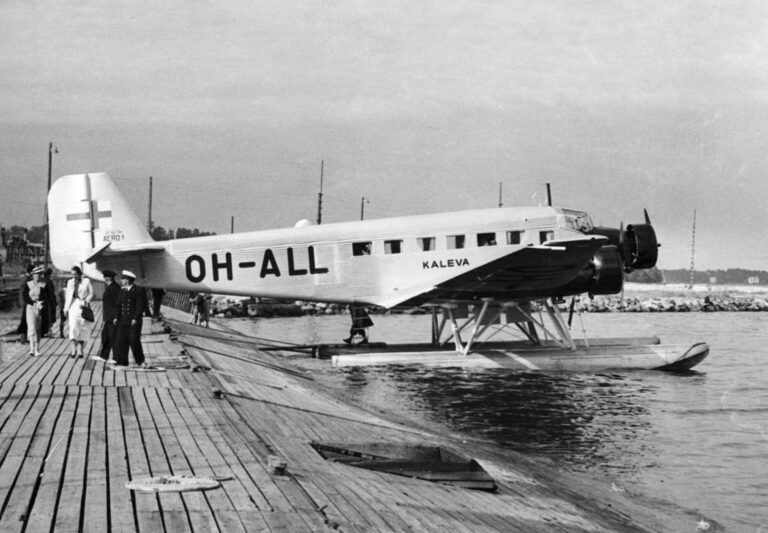The World War II mystery of what happened to a Finnish airliner after it was shot down over the Baltic Sea by Soviet bombers finally appears to be solved more than 80 years later.
The plane was carrying American and French diplomatic couriers in June 1940 when it was shot down just days before Moscow’s annexation of the Baltic states. All nine people on board the plane were killed, including the two Finnish crew members and seven passengers – an American diplomat, two Frenchmen, two Germans, a Swede and a dual Estonian-Finnish national.
A diving and salvage team in Estonia said this week it had located well-preserved parts and debris of the Junkers Ju 52 aircraft operated by Finnish airline Aero, now Finnair. It was found off the small island of Keri, near the Estonian capital, Tallinn, at a depth of 70 meters (230 feet).
“Basically, we started from scratch. We took a completely different approach in the search,” said Kaido Peremees, spokesperson for the Estonian diving and underwater survey company Tuukritoode OU, explaining the group’s success in discovering the plane’s remains. .
The civilian plane Kaleva was shot down en route from Tallinn to Helsinki on June 14, 1940, just three months after Finland signed a peace treaty with Moscow following the 1939-40 Winter War.
News of the plane’s fate sparked disbelief and anger among Helsinki authorities who were informed that it had been shot down by two Soviet DB-3 bombers 10 minutes after taking off from Tallinn’s Ulemiste Airport. .
“It is unique that an airliner was shot down in peacetime while on a regular flight,” said Finnish aviation historian Carl-Fredrik Geust, who investigated Kaleva’s case since the 1980s.
Finland officially kept silent for years about the details of the plane’s destruction, publicly claiming that only a “mysterious crash” took place over the Baltic Sea, because it did not want to provoke Moscow .
Although well documented in books, research and television documentaries, the 84-year-old mystery has intrigued Finns. The case forms a key part of the Nordic country’s complex history during World War II and highlights its troubled ties with Moscow.
But perhaps more importantly, the plane’s destruction occurred at a critical time, just days before Joseph Stalin’s Soviet Union prepared to annex the three Baltic states, thus sealing the fate of the Estonia, Latvia and Lithuania for the next half century before they finally took their countries back. independence in 1991.

Recovery by Soviet submarine
The USSR occupied Estonia on June 17, 1940, and Kaleva’s doomed trip was the last flight out of Tallinn, even though the Soviets had already begun to impose a strict embargo on transportation around the Estonian capital .
American diplomat Henry W Antheil Jr, 27, was on board the plane at the time of the disaster. He was on a rushed government mission to evacuate sensitive diplomatic bags from U.S. missions in Tallinn and Riga, Latvia, as it became clear that Moscow was preparing to swallow up the small Baltic nations.
Kaleva was carrying 227 kg (500 pounds) of diplomatic mail, including Antheil’s suitcases and equipment from two French diplomatic couriers – identified as Paul Longuet and Frédéric Marty.
Estonian fishermen and the Keri lighthouse operator told Finnish media, decades after the plane was destroyed, that a Soviet submarine surfaced near the Kaleva crash site and picked up floating debris , including pockets of documents recovered by fishermen on the site.
This gave rise to conspiracy theories regarding the contents of the pouches and Moscow’s decision to shoot down the plane. It remains unclear exactly why the Soviet Union decided to shoot down a Finnish civilian aircraft in peacetime.
“Much speculation about the plane’s cargo has been heard over the years,” Geust said. “What was the plane carrying? Many suggest that Moscow wanted to prevent sensitive materials and documents from leaving Estonia.”
But he added that it could simply be a “mistake” on the part of Soviet bomber pilots.
Various attempts to find Kaleva have been recorded since Estonia regained its independence more than three decades ago. However, none of them were successful.
“The wreck is in pieces and the seabed is quite difficult with rock formations, valleys and hills. It’s very easy to miss small parts and debris from the plane, Peremees said. “The techniques have of course evolved a lot over time. As always, you can have good technology, but be unlucky.
A new video taken by underwater robots from the Peremees company shows clear images of the landing gear of the Junkers trimotor, one of the engines and parts of the wings.
Jaakko Schildt, Finnair’s chief operating officer, described the Kaleva disaster as “a tragic and deeply sad event for the young airline.”
“Finding the wreck of the Kaleva kind of brings closure to this matter, even if it doesn’t bring back the lives of our customers and crew who were lost,” Schildt said. “The interest in the location of Kaleva in the Baltic Sea testifies to the importance of this tragic event in the aviation history of our region.”


